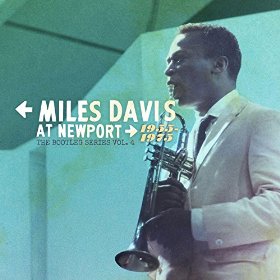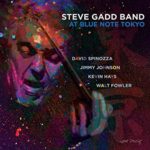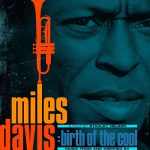Artist: Miles Davis
Album: Miles Davis at Newport 1955-1975: The Bootleg Series Vol. 4
Label: Columbia/Legacy Records
Release Date: 07/17/2015

Thanks to the miracle of archiving, “The Man With The Horn” is alive again, a metamorphosis before our very ears in the kind of setting that did him the most justice throughout his decades long artistic odyssey– live.
Featuring four discs of musical collages taken from eight Newport Jazz Festival live performances, this collection puts Miles squarely in the forefront, but also makes for wonderful listening because of the legendary backing players that help shape his notable peppy quintets and rollicking funk bands. Here, Miles gets to blow his horn to his heart’s content, and that he does with the pure vigor of a mad musical scientist.
As time progresses, so to does Miles’ sound. Starting in 1955, you can instantly picture Miles draped in a tailored suit, looking spotless and sounding pristine, his notes crisp and to the point, complemented by greats like Thelonius Monk and Gerry Mulligan.
Moving on to 1958, you come to realize how amazing it is that Miles’ bandmates never once try to show him up. The names speak for themselves: Cannonball Adderly, John Coltrane, Bill Evans! No matter the incarnation, all players know which notes to start and end with, giving them the freedom to create a spectacular middle of improvisation and jamming.
The 1966 and 1967 Newport shows start to get a little more intense. This could be due to the fact that young Herbie Hancock, Wayne Shorter and Tony Williams were already prepping for their forthcoming fusion leanings. Listening to a sped up version of “So What,” led by Hancock’s mighty two chord stomp, you know a whole new genre of jazz is fast on its way to the masses.
Meanwhile, CDs three and four, which encompass Miles’ successful Bitches Brew era, defy the conceptions of jazz. “It’s About That Time/The Theme” on CD three becomes an improvised fusion race between Miles’ horn blasts and Chick Corea’s electric piano notes. The result is a clear cut tie: both men know how to enthrall each other and an audience at the same time. Ultimately, the keyboard torch gets passed to Keith Jarrett later on in the collection, and the future improvisation king lets his flurried fingers cradle Miles’ notes firmly and sweetly.
The 1973 Newport show in Berlin, Germany and the 1971 Newport show in Switzerland are particular delights as Miles plugs his horn into a wah-wah pedal, making him the Jimi Hendrix of brass. “Turnaroundphrase” and “What I Say” are standouts, but each track, no matter how unwieldy they may sound, flow easily into one another. Think of each respective performance as a cloudburst of sheer virtuosic creativity.
Just as Miles’ catalog is broken up by different jazz genres, this set does a superb job of giving us a little bit of everything. We hear the modal jazz that put him on the musical map with Kind of Blue, the bop that helped spread his name throughout jazz player circles and the fusion that revolutionized the way a jazz instrument could be played. No matter how many icons played with him over time, Miles was the master. Now, thanks to this collection, he still is!
– Ira Kantor







[…] Jazz fans have truly been blessed this year, as this marks the fourth album of renowned alto saxophonist Art Pepper reissued in 2015 alone. As great as the three volumes under the Neon Art banner were, this recording, from a 1981 engagement in New York’s Fat Tuesday’s, is even better due to the amazing energy and the assemblage of top flight talent. Here, Pepper is accompanied by his long-time cohort, pianist Milcho Leviev and guests: bassist George Mraz (associated often with Oscar Peterson) and drummer Al Foster (associated with Miles Davis). […]